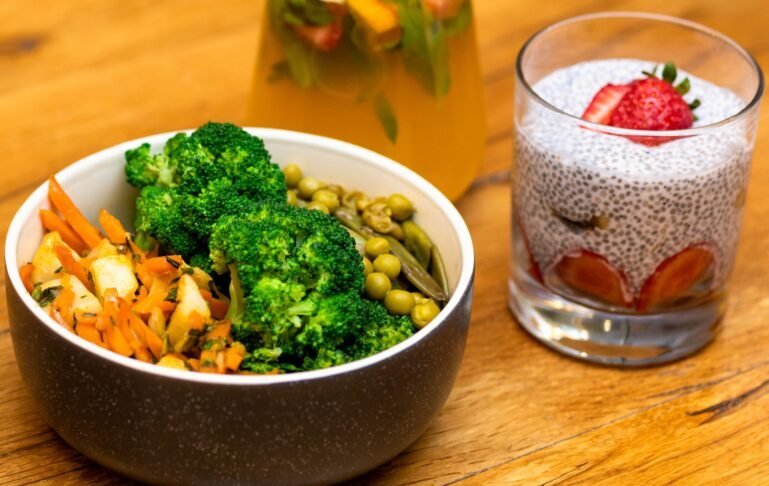KETO
The Ketogenic Diet

A Beginner’s Guide
A ketogenic diet (also known as a keto diet) is a low carb, high fat diet that offers many health benefits. There are many studies which show that this type of diet can help you lose weight and improve your health.
A ketogenic diet is a very low carb, high fat diet that shares many similarities with the Atkins and low carb diets. It involves drastically reducing carbohydrate intake and replacing it with fat.
This reduction in carbs puts your body into a metabolic state called ketosis. When this happens, your body becomes incredibly efficient at burning fat for energy. It also turns fat into ketones in the liver, which can supply energy for the brain. Ketogenic diets are also known to cause significant reductions in blood sugar and insulin levels.
Types of Ketogenic Diets
Standard Ketogenic Diet (SKD): A very low carb, moderate protein and high fat diet which typically contains 70% fat, 20% protein, and only 10% carbs.
Cyclical Ketogenic Diet (CKD): A diet which involves periods of higher carb refeeds e.g 5 ketogenic days followed by 2 high carb days.
Targeted Ketogenic Diet (TKD): A diet which allows you to add carbs around workouts.
High Protein Ketogenic Diet (HPKD): A diet similar to a standard ketogenic diet but includes more protein. A typical ratio is usually 60% fat, 35% protein, and 5% carbs.
The standard and high protein ketogenic diets are more common whilst the cyclical or targeted ketogenic diets are primarily used by bodybuilders or athletes.

More about ketoGENIC diets
- KETOSIS
- LOSING WEIGHT
- DIABETICS AND PREDIABETES
- TYPICAL FOODS TO AVOID
- AN IDEAL DIET
- POSSIBLE SIDE EFFECTS AND HOW TO MINIMISE THEM
A metabolic state in which your body uses fat for fuel instead of carbs. This happens when you significantly reduce your consumption of carbohydrates, limiting your body’s supply of glucose (sugar), which is the usual source of energy for the body.
A ketogenic diet is the most effective way to enter ketosis and involves limiting carb consumption to around 20 to 50g per day and filling up on fats, such as meat, fish, eggs, nuts, and healthy oils.
It is important to moderate your protein consumption because protein can be converted into glucose if consumed in high amounts, which then slows your transition into ketosis.
Practicing intermittent fasting can also help you enter ketosis faster and the most common method involves limiting food intake to around 8 hours per day and fasting for the remaining 16 hours.
Blood, urine, and breath are tests you can take to help determine whether you have entered ketosis by measuring the amount of ketones produced by your body. Non intrusive means include increased thirst, dry mouth, frequent urination, and decreased hunger or appetite.
.
A ketogenic diet is an effective way to lose weight and lower risk factors for disease.
Research has shown that a ketogenic diet is as effective for weight loss as a low fat diet and this diet is so filling that you can lose weight without having to count calories or track your food intake.
Diabetes is characterized by changes in metabolism, high blood sugar, and impaired insulin function.
A ketogenic diet can help you lose excess fat, which is closely linked to type 2 diabetes, prediabetes, and metabolic syndrome.
Any food that is high in carbs should be limited as well as the following:
- Sugary Foods: soda, fruit juice, smoothies, cake, ice cream, candy, etc.
- Grains or Starches: wheat-based products, rice, pasta, cereal, etc.
- Fruits: All except small portions of berries like strawberries
- Beans or Legumes: peas, kidney beans, lentils, chickpeas, etc.
- Root Vegetables and Tubers: potatoes, sweet potatoes, carrots, parsnips, etc.
- Low Fat or Diet Products: low fat mayonnaise, salad dressings, and condiments
- Condiments or Sauces: barbecue sauce, honey mustard, teriyaki sauce, ketchup, etc.
- Unhealthy Fats: processed vegetable oils, mayonnaise, etc.
- Alcohol: beer, wine, liquor, mixed drinks
- Sugar-Free Diet Foods: sugar-free candies, syrups, puddings, sweeteners, desserts, etc.
It is best to base your diet mostly on whole, single-ingredient foods and include the following:
- Meat: red meat, steak, ham, sausage, bacon, chicken, and turkey
- Fatty Fish: salmon, trout, tuna, and mackerel
- Eggs: pastured or omega-3 whole eggs
- Butter and Cream: grass-fed butter and heavy cream
- Cheese: unprocessed cheeses like cheddar, goat, cream, blue, or mozzarella
- Nuts and Seeds: almonds, walnuts, flaxseeds, pumpkin seeds, chia seeds, etc.
- Healthy Oils: extra virgin olive oil, coconut oil, and avocado oil
- Avocados: whole avocados or freshly made guacamole
- Low Carb Veggies: green veggies, tomatoes, onions, peppers, etc.
- Condiments: salt, pepper, herbs, and spices
The ketogenic diet is usually safe for most healthy people but there may be some initial side effects while your body adapts.
Often referred to as the ‘keto flu’, it is usually over within a few days and the typical symptoms include diarrhea, constipation, and vomiting. You may also experience poor energy and mental function as well as increased hunger, sleep issues, nausea, digestive discomfort and decreased exercise performance.
To manage this, you can try a regular low carb diet for the initial weeks. This will teach your body to burn more fat before you completely eliminate carbs.
A ketogenic diet can also change the water and mineral balance of your body, so adding extra salt to your meals or taking mineral supplements may help. Always consult your doctor about your nutritional needs and before embarking on a ketogenic diet change.
Source: https://www.healthline.com/nutrition/ketogenic-diet-101
